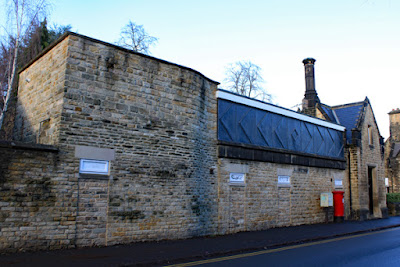Leaving Edgebrook Road, I was confronted by a large elongate building that first appears on the 1906 edition Ordnance Survey map at the edge of a complex of buildings that grew around the Ecclesall Bierlow Union Workhouse – designed by William Flockton and built in 1844 – before being converted into Nether Edge Hospital, which now operates only a few specialist departments.
From a single photograph taken at a distance, I can see that the colour of the sandstone used for the walling and the dressings looks quite different to the sandstones used in the boundary wall. As I had discovered during my walks around the Broomhill and Broomhall Conservation Areas, local stone from the Chatsworth Grit, Rough Rock and Crawshaw Sandstone dominate the western suburbs and surrounding areas of Sheffield, but the best buildings – including King Edward VII School (1838) and The Mount (c.1830) by William Flockton – used Derbyshire gritstone for ashlar.
In the Mineral statistics of the United Kingdom of Great Britain and Ireland by R. Hunt, published in 1858, the major stone producing areas of Sheffield were Crookes, with an average output of 25,800 tons of Crawshaw Sandstone for pavers, blocks and building stone and Brincliffe Edge, which produced 14,400 tons of Brincliffe Edge Rock (Greenmoor Rock): flags, steps, heads, sills, gravestones and walling stone.
Most of the Crawshaw Sandstone that I have knowingly seen as a building stone is in the Sheffield Board Schools, where its uniform buff colour, medium grained texture and its distinctive planar bedding make it quite recognisable; however, much of the stone seen in the terraced housing of Crookes and Walkley can be more variable in colour, with iron staining being common.
The Greenmoor Rock is much finer grained and isn’t generally seen with a bed height much greater than 150 mm and, except for heads and sills, a much more massive sandstone is always used for the quoins and dressings. The Greenmoor Rock around Brincliffe Edge was once known as Brincliffe Blue, because of its blue/grey colour, which differs to the green/grey colour of the formation around Green Moor, which contains the mineral chlorite that is derived from weakly metamorphosed volcanic rock some distance to the west.
Apart from its very fine grain size and distinctive colour, which distinguishes it from most of the other sandstones around Sheffield, very dense concentrations of rusty brown iron oxides/hydroxides commonly appear on the joint faces. This is particularly noticeable in the thin bedded stone used for boundary walls and the walling stone of cottages and agricultural buildings.
Walking down Union Road, I briefly stopped to look at the stonework of a much altered building/section of wall to the south of the Left Lodge (1843) at the former workhouse, which was the next on my list to photograph for the British Listed Buildings website.
From my photos, I can clearly see variations in the heights of the beds of the various courses of masonry, including thin courses of stone that I would say are Greenmoor Rock, but the more massive varieties have a distinctly orange to grey variation that reminds me of the Loxley Edge Rock that I have seen at Malin Bridge, Wadsley and at the Sheffield Royal Infirmary, but I can’t really tell the grain size from my photographs.
The stonework of the Right Lodge (1843) is much dirtier, but I can still see an orange colouration, sometimes as Liesegang rings, but again I didn’t look closely at this and can’t glean much information from the photos, although at the time my attention was drawn to the coarse grained sandstone used for the plinth and dressings.
The Grade II Listed Kingswood Building, which formed part of the original workhouse, could only be viewed from a distance but the masonry has been cleaned at some point in the not too distant past. The walling is light buff with some yellowish variations but it contains no strong iron staining and looks like Crawshaw Sandstone from Crookes. The dressings are made of a massive sandstone with a much paler uniformly buff colour, which is probably from Derbyshire.
On the opposite site of the road are the Edwardian old workhouse offices, which has a very similar pale coloured walling stone to the Kingswood Building, with massive sandstone dressings; however, the dressings look to be darker in colour than the Derbyshire gritstone and are more like the Crosland Hill stone from Huddersfield, as seen at the Central Schools on Leopold Street.
Continuing along Union Road, the next building of interest that I encountered, although not listed, was the old Methodist Chapel on the corner with Osborne Road. The walling looks like it is thinly bedded and laminated Greenmoor Rock, but with it being quite grimy and in the shade, I can’t see its characteristics very well. Massive medium grained sandstone from the Millstone Grit of Derbyshire, with a very large block size, has been used for the pilasters and door surrounds.
 |
| The former Methodist chapel on Union Road |












No comments:
Post a Comment